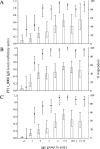Immunoglobulin G antibody reactivity to a group A Plasmodium falciparum erythrocyte membrane protein 1 and protection from P. falciparum malaria
- PMID: 17283085
- PMCID: PMC1865733
- DOI: 10.1128/IAI.00951-06
Immunoglobulin G antibody reactivity to a group A Plasmodium falciparum erythrocyte membrane protein 1 and protection from P. falciparum malaria
Abstract
Variant surface antigens (VSA) on the surface of Plasmodium falciparum-infected red blood cells play a major role in the pathogenesis of malaria and are key targets for acquired immunity. The best-characterized VSA belong to the P. falciparum erythrocyte membrane protein 1 (PfEMP1) family. In areas where P. falciparum is endemic, parasites causing severe malaria and malaria in young children with limited immunity tend to express semiconserved PfEMP1 molecules encoded by group A var genes. Here we investigated antibody responses of Tanzanians who were 0 to 19 years old to PF11_0008, a group A PfEMP1. PF11_0008 has previously been found to be highly transcribed in a nonimmune Dutch volunteer experimentally infected with NF54 parasites. A high proportion of the Tanzanian donors had antibodies against recombinant PF11_0008 domains, and in children who were 4 to 9 years old the presence of antibodies to the PF11_0008 CIDR2beta domain was associated with reduced numbers of malaria episodes. These results indicate that homologues of PF11_0008 are present in P. falciparum field isolates and suggest that PF11_0008 CIDR2beta-reactive antibodies might be involved in protection against malaria episodes.
Figures




Similar articles
-
Plasmodium falciparum associated with severe childhood malaria preferentially expresses PfEMP1 encoded by group A var genes.J Exp Med. 2004 May 3;199(9):1179-90. doi: 10.1084/jem.20040274. J Exp Med. 2004. PMID: 15123742 Free PMC article.
-
IgG antibodies to endothelial protein C receptor-binding cysteine-rich interdomain region domains of Plasmodium falciparum erythrocyte membrane protein 1 are acquired early in life in individuals exposed to malaria.Infect Immun. 2015 Aug;83(8):3096-103. doi: 10.1128/IAI.00271-15. Epub 2015 May 26. Infect Immun. 2015. PMID: 26015475 Free PMC article.
-
Antibodies from malaria-exposed pregnant women recognize trypsin resistant epitopes on the surface of Plasmodium falciparum-infected erythrocytes selected for adhesion to chondroitin sulphate A.Malar J. 2004 Sep 6;3:31. doi: 10.1186/1475-2875-3-31. Malar J. 2004. PMID: 15350207 Free PMC article.
-
PfEMP1: an antigen that plays a key role in the pathogenicity and immune evasion of the malaria parasite Plasmodium falciparum.Int J Biochem Cell Biol. 2009 Jul;41(7):1463-6. doi: 10.1016/j.biocel.2008.12.012. Epub 2008 Dec 25. Int J Biochem Cell Biol. 2009. PMID: 19150410 Review.
-
The role of PfEMP1 as targets of naturally acquired immunity to childhood malaria: prospects for a vaccine.Parasitology. 2016 Feb;143(2):171-86. doi: 10.1017/S0031182015001274. Epub 2016 Jan 7. Parasitology. 2016. PMID: 26741401 Free PMC article. Review.
Cited by
-
Allelic diversity of the Plasmodium falciparum erythrocyte membrane protein 1 entails variant-specific red cell surface epitopes.PLoS One. 2011 Jan 27;6(1):e16544. doi: 10.1371/journal.pone.0016544. PLoS One. 2011. PMID: 21298021 Free PMC article.
-
Analysis of antibody induction upon immunization with distinct NTS-DBL1α-domains of PfEMP1 from rosetting Plasmodium falciparum parasites.Malar J. 2013 Jan 24;12:32. doi: 10.1186/1475-2875-12-32. Malar J. 2013. PMID: 23347690 Free PMC article.
-
The humoral response to Plasmodium falciparum VarO rosetting variant and its association with protection against malaria in Beninese children.Malar J. 2010 Oct 5;9:267. doi: 10.1186/1475-2875-9-267. Malar J. 2010. PMID: 20923548 Free PMC article.
-
Comprehensive analysis of Fc-mediated IgM binding to the Plasmodium falciparum erythrocyte membrane protein 1 family in three parasite clones.Sci Rep. 2019 Apr 15;9(1):6050. doi: 10.1038/s41598-019-42585-0. Sci Rep. 2019. PMID: 30988351 Free PMC article.
-
Surface co-expression of two different PfEMP1 antigens on single plasmodium falciparum-infected erythrocytes facilitates binding to ICAM1 and PECAM1.PLoS Pathog. 2010 Sep 2;6(9):e1001083. doi: 10.1371/journal.ppat.1001083. PLoS Pathog. 2010. PMID: 20824088 Free PMC article.
References
-
- Baruch, D. I., B. Gamain, J. W. Barnwell, J. S. Sullivan, A. Stowers, G. G. Galland, L. H. Miller, and W. E. Collins. 2002. Immunization of Aotus monkeys with a functional domain of the Plasmodium falciparum variant antigen induces protection against a lethal parasite line. Proc. Natl. Acad. Sci. USA 99:3860-3865. - PMC - PubMed
-
- Baruch, D. I., J. A. Gormely, C. Ma, R. J. Howard, and B. L. Pasloske. 1996. Plasmodium falciparum erythrocyte membrane protein 1 is a parasitized erythrocyte receptor for adherence to CD36, thrombospondin, and intercellular adhesion molecule 1. Proc. Natl. Acad. Sci. USA 93:3497-3502. - PMC - PubMed
-
- Baruch, D. I., X. C. Ma, B. Pasloske, R. J. Howard, and L. H. Miller. 1999. CD36 peptides that block cytoadherence define the CD36 binding region for Plasmodium falciparum-infected erythrocytes. Blood 94:2121-2127. - PubMed
-
- Baruch, D. I., B. L. Pasloske, H. B. Singh, X. Bi, X. C. Ma, M. Feldman, T. F. Taraschi, and R. J. Howard. 1995. Cloning the P. falciparum gene encoding PfEMP1, a malarial variant antigen and adherence receptor on the surface of parasitized human erythrocytes. Cell 82:77-87. - PubMed
-
- Bian, Z., G. Wang, X. Tian, and J. Fan. 1999. Expression of Plasmodium falciparum-infected erythrocyte membrane protein from cerebral malaria patients. Zhongguo Jiehe Sheng Chong Xue Yu Ji Sheng Chong Bing Za Zhi 17:359-362. [Chinese.] - PubMed
Publication types
MeSH terms
Substances
LinkOut - more resources
Full Text Sources
Research Materials

